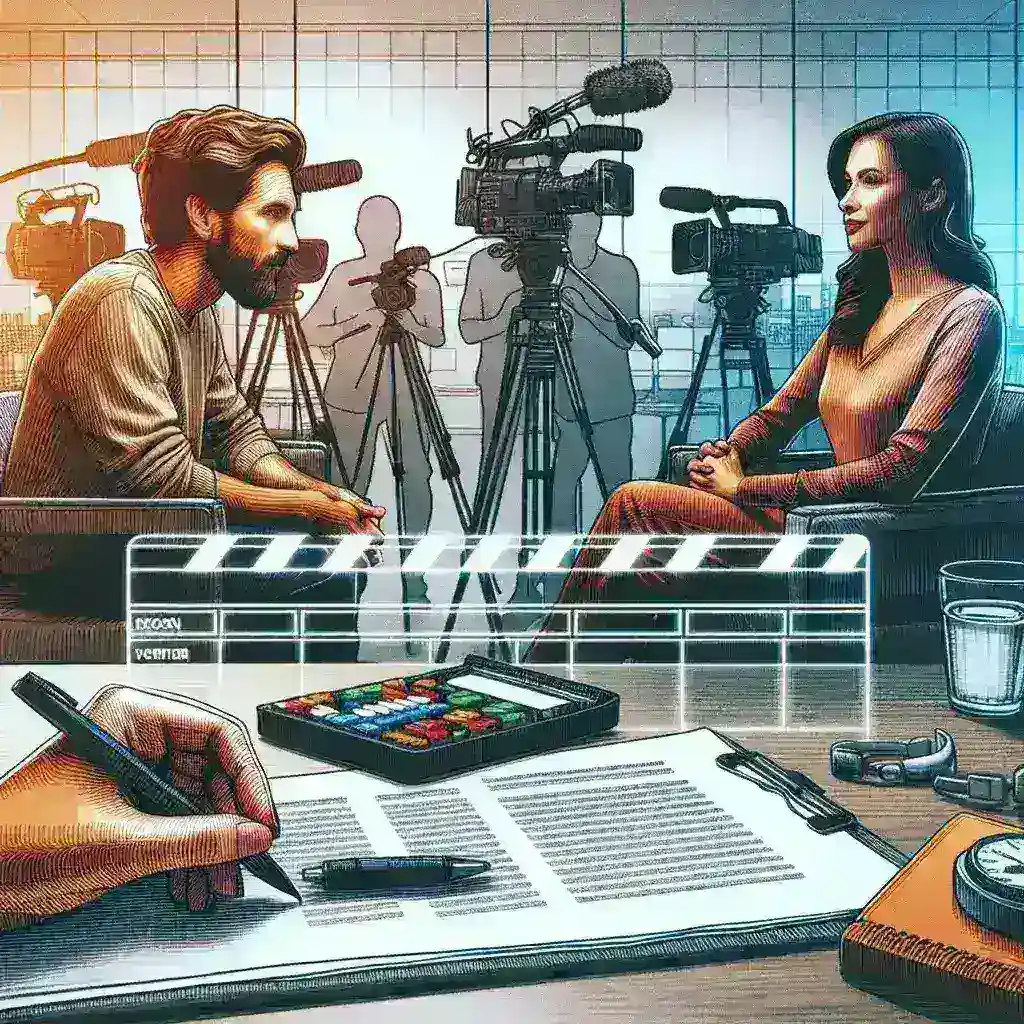
How to Add Lower Thirds to Interviews: A Complete Guide for Professional Video Production
Lower thirds are essential graphic elements that can transform ordinary interviews into polished, professional productions. These text overlays, positioned in the lower portion of the screen, provide crucial information about speakers while maintaining visual appeal and credibility. Understanding how to implement them effectively can significantly enhance your video content’s impact and viewer engagement.
Understanding Lower Thirds in Interview Production
Lower thirds serve as informational anchors that identify speakers, provide context, and establish credibility without disrupting the natural flow of conversation. These graphics typically appear in the bottom third of the screen, hence their name, and contain essential details such as the interviewee’s name, title, company, or relevant credentials.
The strategic placement of lower thirds creates a seamless viewing experience while ensuring audiences can easily identify who is speaking. This becomes particularly valuable in documentary-style interviews, corporate communications, news segments, and educational content where speaker identification is crucial for maintaining audience trust and comprehension.
Essential Components of Effective Lower Thirds
Professional lower thirds consist of several key elements that work together to create cohesive visual communication. The primary text typically features the speaker’s name in a clear, readable font, while secondary text provides additional context such as job titles, company names, or relevant expertise areas.
Background elements, including colored bars, transparent overlays, or geometric shapes, help separate text from the video content while maintaining visual hierarchy. Color schemes should align with brand guidelines or complement the overall video aesthetic, ensuring consistency across all interview segments.
Planning Your Lower Third Strategy
Before diving into technical implementation, developing a comprehensive strategy ensures consistency and professionalism throughout your interview series. Consider your target audience, brand identity, and the specific context of each interview when designing your approach.
Timing plays a crucial role in lower third effectiveness. Generally, these graphics should appear shortly after a speaker begins talking, remain visible long enough for viewers to read comfortably, and disappear before becoming distracting. Most professionals recommend displaying lower thirds for 5-8 seconds during initial introductions and 3-5 seconds for subsequent appearances.
Content Guidelines for Interview Lower Thirds
Crafting appropriate text content requires balancing informativeness with brevity. Primary text should always include the speaker’s full name, while secondary text can feature titles, affiliations, or expertise areas relevant to the discussion topic.
Avoid overwhelming viewers with excessive information. Stick to essential details that enhance understanding and credibility. For experts or thought leaders, highlighting specific achievements or areas of specialization can add valuable context that supports their statements and opinions.
Technical Implementation Methods
Modern video editing software offers multiple approaches for creating and implementing lower thirds. Adobe Premiere Pro, Final Cut Pro, DaVinci Resolve, and other professional editing platforms provide built-in tools and templates that streamline the process.
For beginners, template-based approaches offer quick solutions with professional results. These pre-designed graphics can be customized with specific text, colors, and timing to match your project requirements. More advanced users might prefer creating custom lower thirds from scratch, allowing complete control over design elements and animations.
Software-Specific Techniques
Adobe Premiere Pro users can leverage the Essential Graphics panel to create dynamic lower thirds with customizable parameters. This workflow allows editors to build reusable templates that maintain consistency across multiple interviews while enabling quick text updates for different speakers.
Final Cut Pro offers similar functionality through its Titles and Generators, providing drag-and-drop simplicity combined with extensive customization options. The software’s magnetic timeline makes positioning and timing adjustments intuitive, even for complex interview sequences.
DaVinci Resolve’s Fusion page enables sophisticated motion graphics creation, perfect for users seeking advanced animation capabilities. The node-based workflow allows for complex compositions while maintaining efficient rendering performance.
Design Best Practices for Professional Results
Visual consistency forms the foundation of professional lower third design. Establish clear guidelines for font choices, color palettes, sizing, and positioning that align with your brand identity and overall video aesthetic.
Typography selection significantly impacts readability and professional appearance. Sans-serif fonts typically work best for lower thirds, offering clean lines and excellent legibility across various screen sizes and resolutions. Avoid overly decorative or script fonts that might compromise readability, especially on smaller displays.
Color Theory and Contrast Considerations
Effective color schemes ensure optimal contrast between text and background elements while supporting brand recognition. High contrast combinations improve readability, while complementary colors create visual harmony that doesn’t distract from the interview content.
Consider the interview environment when selecting colors. Backgrounds with varying lighting conditions or busy visual elements require careful color choices to maintain text visibility throughout the segment. Testing your designs across different monitor types and viewing conditions helps ensure consistent performance.
Animation and Timing Strategies
Subtle animations can enhance lower thirds without overwhelming the content. Simple fade-ins and fade-outs provide smooth transitions that feel natural and professional. More elaborate animations should be used sparingly and only when they serve a specific purpose or align with your brand style.
Timing coordination with interview pacing creates seamless integration between graphics and spoken content. Lower thirds should appear after speakers begin talking, allowing viewers to focus on the person before introducing identifying information. This approach feels more natural and less intrusive than immediate graphic appearances.
Advanced Animation Techniques
Motion graphics experts often incorporate subtle movement within lower thirds to maintain visual interest without distraction. Gentle scaling, sliding, or rotation effects can add sophistication while preserving readability and professional appearance.
Keyframe animation allows precise control over timing and movement, enabling custom effects that perfectly match your project’s needs. However, restraint remains crucial – the goal is enhancing communication, not showcasing animation skills.
Quality Control and Testing Procedures
Thorough testing ensures your lower thirds perform consistently across different viewing platforms and devices. Preview your work on various screen sizes, from mobile phones to large monitors, checking for readability and proper positioning.
Spelling accuracy and factual verification are critical for maintaining credibility. Double-check all names, titles, and company information before finalizing your project. Consider implementing a review process where multiple team members verify content accuracy.
Platform-Specific Considerations
Different distribution platforms may have specific requirements or limitations that affect lower third design. Social media platforms often crop videos differently, potentially cutting off lower portions where graphics appear. YouTube, LinkedIn, and other platforms may have varying optimal text sizes and positioning guidelines.
Broadcasting standards for television or streaming services typically include specific safe area requirements that ensure graphics remain visible across all viewing devices. Understanding these technical specifications early in the design process prevents costly revisions later.
Common Mistakes and How to Avoid Them
Overcrowding represents one of the most frequent lower third mistakes. Attempting to include too much information creates cluttered graphics that are difficult to read and visually overwhelming. Focus on essential information and consider using multiple lower thirds throughout an interview if additional context is necessary.
Poor timing can make even well-designed lower thirds feel awkward or intrusive. Graphics that appear too early, stay too long, or disappear too quickly disrupt the viewing experience and can distract from the interview content.
Technical Pitfalls to Avoid
Resolution and scaling issues can make lower thirds appear pixelated or improperly sized when exported to different formats. Always work at your final output resolution and test exports thoroughly before distribution.
Font licensing represents an often-overlooked consideration that can cause legal issues if commercial fonts are used without proper licensing. Stick to system fonts or properly licensed typefaces to avoid potential complications.
Advanced Techniques for Professional Enhancement
Experienced video producers often incorporate additional elements that elevate lower thirds beyond basic text identification. Subtle drop shadows, glows, or outlines can improve text visibility against varying backgrounds while adding visual depth.
Brand integration through logo placement, color coordination, and consistent styling creates cohesive visual communication that reinforces organizational identity throughout interview content. This approach is particularly valuable for corporate communications and branded content series.
Multi-language considerations become important for international audiences or diverse communities. Planning for text expansion, character set requirements, and cultural color associations ensures your lower thirds work effectively across different markets and audiences.
Future-Proofing Your Lower Third Workflow
As video production technology continues evolving, maintaining flexible workflows that adapt to new platforms and viewing habits becomes increasingly important. Cloud-based collaboration tools enable team members to work together efficiently while maintaining version control and consistency.
Template libraries and asset management systems streamline production workflows while ensuring brand consistency across multiple projects and team members. Investing time in creating comprehensive template collections pays dividends in long-term efficiency and quality maintenance.
Understanding emerging trends in motion graphics and viewer preferences helps keep your content current and engaging. However, timeless design principles should anchor your approach, ensuring your lower thirds remain effective regardless of changing fashions.
Mastering lower third implementation transforms interview content from amateur recordings into professional productions that engage audiences and communicate effectively. Through careful planning, thoughtful design, and attention to technical details, these seemingly simple graphics become powerful tools for enhancing viewer experience and establishing credibility. Whether you’re producing corporate communications, documentaries, or educational content, professional lower thirds represent an investment in quality that pays dividends in audience engagement and content effectiveness.




Leave a Comment